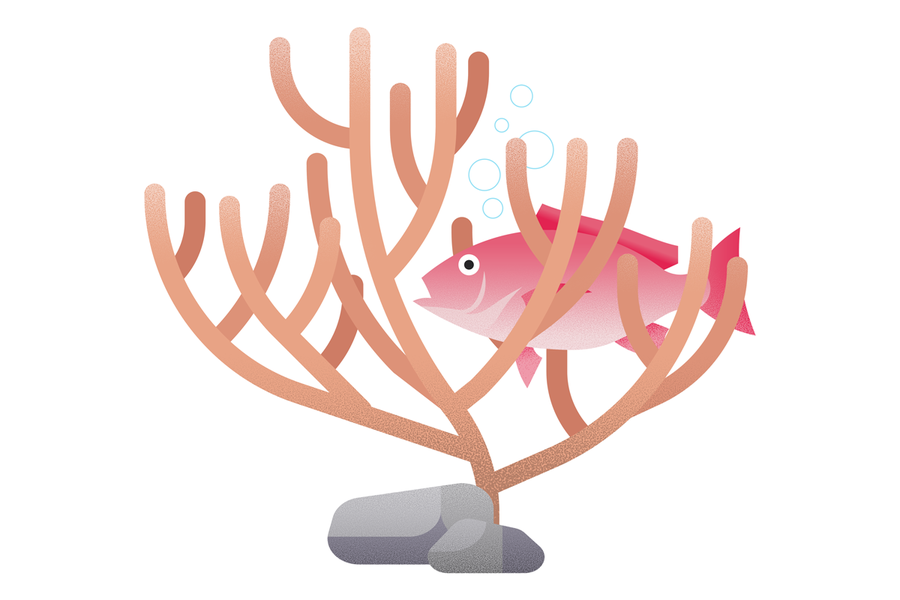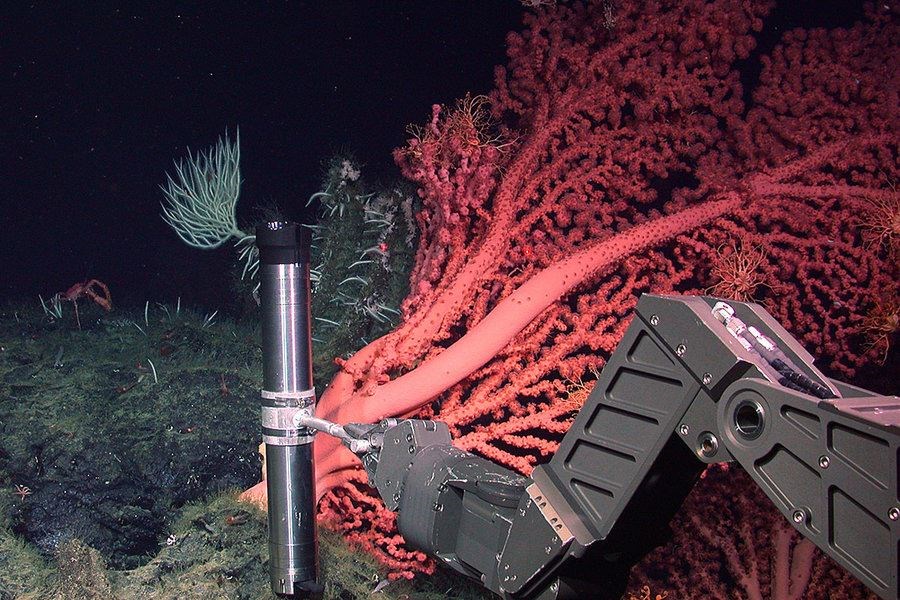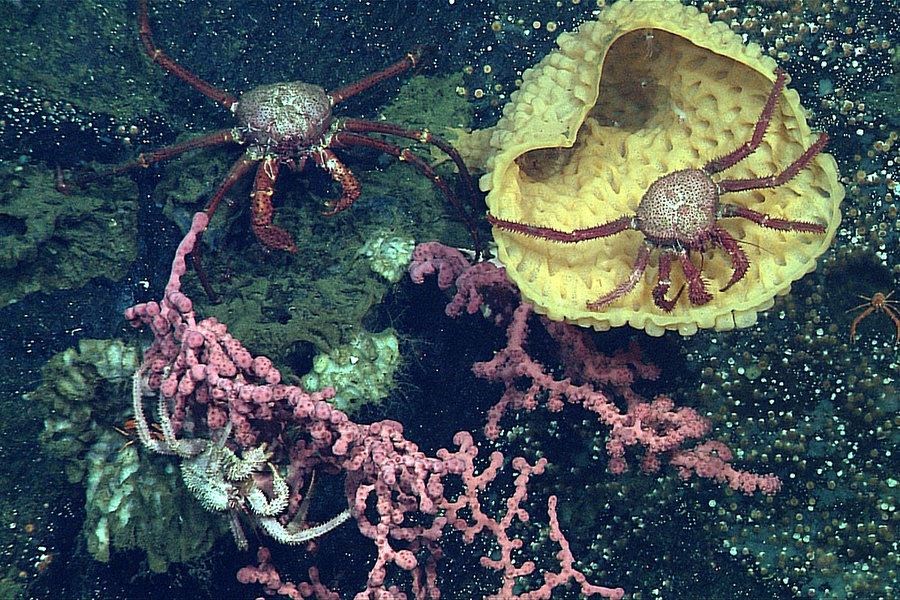Reprinted with permission from The Christian Science Monitor
Few ecosystems spark as much wonder as the coral reef. But discoveries of coral communities on the deep-sea floor have added a layer of mystery to these already awe-inspiring lifeforms. Part 2 of a five-part series exploring our evolving understanding of ocean life.
AUGUST 5, 2019 - MOSS LANDING, CALIF. - Most people can picture a coral reef: A cacophony of color and light and texture, teeming with life just below the waves. But thousands of feet deeper, where light barely filters and waters are cold, acidic, and almost devoid of oxygen, coral reefs also thrive.
 Jacob Turcotte/StaffJacob Turcotte/CSM StaffDespite the harsh conditions, these deep-water reefs are also filled with vibrant color and life: lush gardens of coral and sponges, branches and fans and mounds that are often many hundreds of years old and don’t require sunlight for energy. It’s a more alien world, and a more unknown one, but vitally important within the varied ocean ecosystem in its own way, and also facing threats, just as shallow-water reefs are.
Jacob Turcotte/StaffJacob Turcotte/CSM StaffDespite the harsh conditions, these deep-water reefs are also filled with vibrant color and life: lush gardens of coral and sponges, branches and fans and mounds that are often many hundreds of years old and don’t require sunlight for energy. It’s a more alien world, and a more unknown one, but vitally important within the varied ocean ecosystem in its own way, and also facing threats, just as shallow-water reefs are.
For the scientists studying these remote reefs, it’s easy to tick off reasons why people should care about them: They are important habitats for fish and other species. They’re one piece of the carbon storage that the deep ocean does so effectively, pulling carbon out of the atmosphere and storing it – a critical part of the Earth’s stable climate system. They contain an important record of past ocean climate events in their skeletons. There are potential pharmaceutical and other benefits in corals and sponges that we haven’t begun to tap into.
But perhaps just as important is the simple sense of wonder and mystery that deep-sea reefs can spark, says James Barry, a senior scientist at the Monterey Bay Aquarium Research Institute (MBARI).
“If I can get 10 people to say, ‘That’s really cool, I never thought about anything but the surf,’ that can go a long way in making people think about the ocean,” says Dr. Barry.
“I don’t think you can get a lot more exciting than deep-sea coral communities,” he adds. “They’re iconic, they’re mysterious, they’re really beautiful.”
Dr. Barry has been studying deep-sea corals off the California coast for some 15 years. He points to images on his computer of giant pink “bubblegum coral,” branching yellow bamboo coral, and huge sponges.
“I don’t view them any different than I do an old-growth redwood forest,” he says. “They’re actually older than those, and the complexity of the ecosystem is about the same.”
 The manipulator arm from MBARI’s remotely operated vehicle Tiburon holds a current meter in front of large deep-sea corals on Davidson Seamount, about 75 miles southwest of Monterey, California.© 2006 MBARIUnlike the terrestrial forests, though, researchers are just beginning to understand these deep-sea coral ecosystems: how they can survive such harsh conditions, how they evade predation, how fish and other creatures use them as a habitat, what indications they give us of ocean climate records, and what services they might offer humans.
The manipulator arm from MBARI’s remotely operated vehicle Tiburon holds a current meter in front of large deep-sea corals on Davidson Seamount, about 75 miles southwest of Monterey, California.© 2006 MBARIUnlike the terrestrial forests, though, researchers are just beginning to understand these deep-sea coral ecosystems: how they can survive such harsh conditions, how they evade predation, how fish and other creatures use them as a habitat, what indications they give us of ocean climate records, and what services they might offer humans.
In Monterey Bay, Dr. Barry has been partnering with scientists at the Monterey Bay National Marine Sanctuary, both to do long-term studies of these reefs and to experiment with restoration work: Is it possible to bring coral back to areas devastated by trawling?
Efforts have involved clipping off small branches of large existing corals and moving them to new areas. Early signs have been promising.
“Many of the species have lived well over a year,” says Andrew DeVogelaere, the research coordinator for the marine sanctuary. “What’s more exciting than anything is that some of these corals that we’ve moved now have eggs on them.”
Just finding good deep-sea coral reef sites can be challenging; mapping of the seafloor is rarely detailed. The discovery of Sur Ridge, now the coral observatory site where Dr. Barry and Dr. DeVogelaere are doing their transplant work, was the result of serendipity and a bet between friends.
At the end of 2013, the two scientists were out at sea studying a lost shipping container, and had the unusual experience of finishing their work a day early.
They had long speculated what sort of life might be found on the seafloor at Sur Ridge, a rocky ridge several thousand feet below the surface, about 40 miles offshore. Dr. DeVogelaere thought it was a likely habitat for corals; Dr. Barry thought it would probably be covered in mud.
Together, they selected what seemed a promising location on the map, and sent the remotely operated vehicle down 4,000 feet. Dr. DeVogelaere decided to poke around and see what was there, while Dr. Barry sat in the back of the ROV control room, planning to work on a manuscript.
The remote vehicle encountered a rock wall, Dr. DeVogelaere remembers, channeling the thrill of the dive as he recalls it. “As we approached it I saw this precious coral. Then a bamboo coral. Then a wall of coral. Jim just closed his computer, and he was in for the rest of the day. It was so exciting.”
Deep-sea corals exist throughout the world at a wide variety of latitudes. Just in recent months, scientists exploring the waters off the southeast U.S. coast discovered a massive, deep coral reef that stretches for hundreds of miles, says Erik Cordes, an ecologist at Temple University in Philadelphia. Scientists had known there was some coral there, but nothing close to the extensive, rich ecosystem they found.
 Crabs perch on deep-sea corals and large vase sponges on Sur Ridge, an underwater mountain off the Central California coast.© 2006 MBARI“You’d think the Atlantic coast of Florida was pretty well explored,” says Dr. Cordes. “Every time I go out to sea, I go somewhere that no one has ever been before, and that’s not going to stop. ... I have dozens of undescribed species sitting in my lab – pieces of coral that we didn’t know existed.”
Crabs perch on deep-sea corals and large vase sponges on Sur Ridge, an underwater mountain off the Central California coast.© 2006 MBARI“You’d think the Atlantic coast of Florida was pretty well explored,” says Dr. Cordes. “Every time I go out to sea, I go somewhere that no one has ever been before, and that’s not going to stop. ... I have dozens of undescribed species sitting in my lab – pieces of coral that we didn’t know existed.”
Even in the Gulf of Mexico – also considered relatively well explored – there are huge parts of the seafloor that no one has ever seen. After the Deepwater Horizon oil spill, Dr. Cordes helped examine the impacts to some of those coral reefs, some 4,000 to 6,000 feet below the surface.
“We were discovering coral communities and documenting impacts at the same time,” he says.
Initially, he and others had hoped that impacts from the spill would skip the deep sea, but that wasn’t the case. Instead, oil at the surface got churned up with plankton and other marine organisms, turning the continuous shower of organic detritus known as “marine snow” that bathes the deep sea in nutrients into a “dirty blizzard.”
Dr. Cordes found many corals covered in oil and releasing mucus – a classic coral stress response – while some others had only minor impacts.
In the end, the coral research provided some of the best data on the effects of the spill on marine life.
“Corals are really good sentinels at sea,” says Dr. Cordes. “This coral is sitting right there, we know the oil is fingerprinted back to Deepwater Horizon. It was some of the most compelling evidence of the entire event.”
Like Dr. Barry, Dr. Cordes emphasizes that our understanding of deep-sea coral, while expanding rapidly, is still very much in a discovery phase. Among other things, he hopes that some of the emerging lessons about the remarkable physiology of deep-sea coral will help with understanding the shallow-water corals, which are seeing increasing impacts from warming and acidification.
“The deep-water corals are remarkable,” says Dr. Cordes. “We’re finding them living under conditions we really didn’t think were possible for corals to grow and form skeletons. ... They’re incredibly resilient, and doing things we’re not sure shallow-water corals can do.” If biologists can understand, at the cellular level, how they survive and thrive, he says, there may be lessons that help us understand what makes some shallow-water corals more resilient than others.
Off the coast of California, Dr. Barry is also focused on coral physiology. He’s trying to understand the basic processes that regulate predation, metabolism, and the overall population dynamics of these reefs. And he’s homing in on the threats to deep-water reefs – not just from trawling, which is well understood, but from the changing chemistry in the ocean: falling oxygen levels, rising acidity, warming temperatures.
At this point, it’s still not clear which of those factors will be most important, though there are indicators that they all might pose a threat to some coral species. Dr. Barry suspects that oxygen may be one of the most important.
Many of these corals live in what’s known as the “oxygen minimum zone” – depths of the ocean where oxygen levels are at their lowest. In the waters around Monterey, that’s less than 10% of levels at the surface. Climate change is causing that zone to expand, and it may push some coral past the point where their metabolisms can effectively function.
Dr. Barry is in the process of getting time-lapse cameras placed in their coral observatory so that they can truly watch day-to-day interactions in the way that most ecologists do in terrestrial ecosystems, but that’s rarely possible in the deep sea.
Dr. DeVogelaere, like Dr. Barry, can tick off utilitarian reasons why understanding the threats to these deep-sea organisms matters. But he also stresses a moral obligation to biodiversity.
“We’re here now. And we’re living with these ancient, beautiful creatures,” Dr. DeVogelaere says. “And it’s our decision, and the rest of the public’s, if we want the next generation to be able to see them.”
Page created on 8/5/2019 4:48:10 PM
Last edited 8/5/2019 5:01:54 PM
